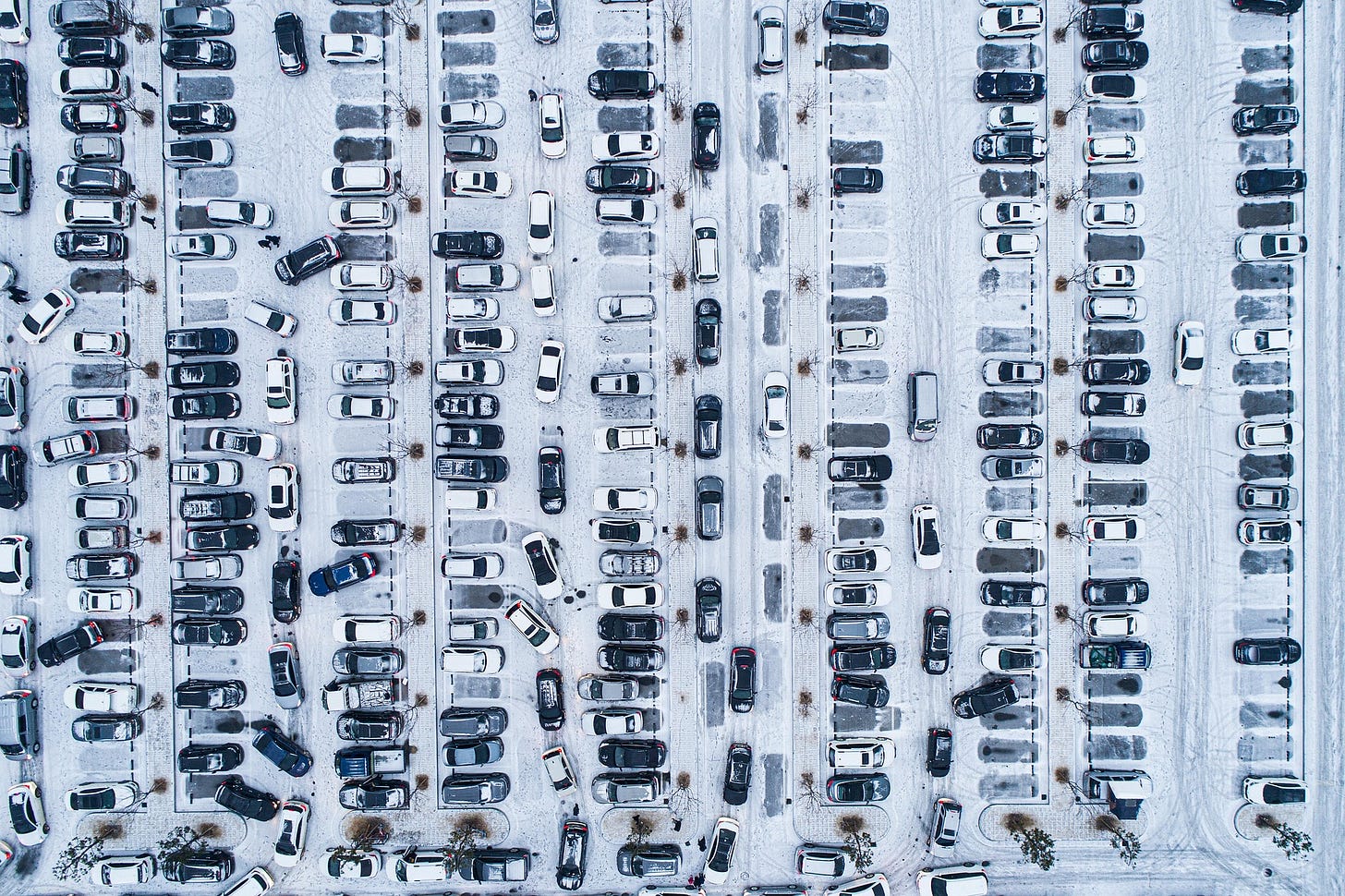Apps Are the New Asphalt
We are still designing our world around the smartphone, even though its days may be numbered
A few weeks ago I joined the counter-revolution: I bought a dumbphone. Not one of these fancy boutique dumbphones, either, but the most basic dumbphone I could find – the Bic biro of telephony – a Nokia 32-10. It’s true, this Luddite transgression against the norms of technological change brought its own silly thrill, a bit like driving after three pints or telling a rude joke.
The 32-10 was released in 1999, around the time an illustrious economist was predicting the Internet would have no greater impact than the fax machine. Last year – after a quarter century and 160 million units sold – it was reissued in a slightly updated form. The model has lasted because it performs a narrow range of functions quite well, and in particular, doesn’t need to be charged very often. One could argue that the 32-10 represents the pinnacle of mass-market mobile phone design, given that mobile phones were never intended for shopping, trading stocks, or collecting and selling information about our lives.
I won’t bore you with my personal reasons for ditching the smartphone; chances are you’ve heard them already, or experienced them yourself. Besides, I haven’t really ditched the smartphone. I fire it up when I need to use WhatsApp – increasingly the only way that people are willing to communicate – or when I want to do something that requires a pocket-sized computer. Then I transfer my SIM back to the dumbphone, a simple trick to remove the ready-to-hand quality that makes the smartphone so invasive.
What I will venture is an argument against the smartphone dependent society: the situation where this device becomes increasingly necessary to access basic services and participate in public life. The smartphone has now completed its transition from exciting novelty to instrument of daily drudgery. Businesses and governments have long since realised that it offers a way to cut costs by offloading administrative tasks onto their customers and users, justifying this “shadow work” as more convenient (sometimes it is, sometimes it isn’t). We are drifting into a world of QR-code menus in restaurants, digital check-in at unmanned hotels, and endless apps required by everyone from estate agents to gyms. The British government recently promised to introduce an app for users of the National Health Service, and smartphones will presumably be central to its new plans for digital ID.
This seems like a foolish road to be going down. The corrosive effects of smartphones will only get worse as we stich them further into the fabric of daily life. And if you subscribe to the religion of technological progress, remember that semiconductor-based technologies have not stopped evolving. We may find we have overhauled the structures of life to accommodate the smartphone just as the gadget is becoming obsolete.
The writer and musician Owen Haacke draws an interesting parallel between the smartphone dependent society and decisions taken in the last century to design our built environment around cars. It is an apt comparison. The automobile was a revolutionary technology, but a big part of the revolution came from the eagerness of planners and developers to facilitate a car-based way of life. The United States is perhaps the most notorious example, with its sprawling cities, suburbs lacking local amenities, and neglect of public transport and pedestrian infrastructure. Haacke notes that “asphalt and pavement dedicated to moving and parking cars” accounts for nearly 80%1 of the area of Houston, and 60% of Los Angeles. In L.A. County parking surfaces alone cover an estimated 200 square miles, more than eight times the size of Manhattan.
In Britain, meanwhile, the 1960s saw a rampage of car-centric redevelopment, as Modernist planners sent motorways ploughing through the historic cores of numerous cities, including Birmingham, Glasgow, Leeds, Leicester, Derby and Coventry. London narrowly escaped being carved up by three enormous ring roads, eight lanes apiece, which would have displaced 100,000 people. (One section that was built, the Westway, became a setting in J.G. Ballard’s 1973 masterpiece Crash, a novel that explores the latent violence and despair of a world made for cars rather than people. When the Westway was opened in 1970, local residents festooned their houses with a giant banner reading “GET US OUT OF THIS HELL: REHOUSE US NOW”). The assumption that the future belonged to the motorist also inspired the Beeching Cuts of the’60s, a decimation of the British rail network that it has never recovered from.
We have paid a high cost for these design decisions – in pollution and stress, in the health problems that stem from sedentary lifestyles, and in neighbourhoods blighted by busy roads or an absence of public space. In Britain, with its legions of cars stuttering around a small land area, the drone of A-roads is impossible to escape even in relatively rural areas. And once car dependence is entrenched, it is very difficult to dial back. Since so many of us need to drive on a daily basis, policies to limit the impact of cars provoke a lot of resentment.
Digital technologies have been embraced in a similarly reckless and presumptuous way to cars, as the example of education shows. The non-profit One Laptop Per Child spent hundreds of millions of dollars on laptop PCs for children in poor countries, despite warnings from those places that they had more fundamental needs (clean drinking water and electricity, for instance). The scheme’s architect, Nicholas Negroponte, modestly claimed, “if I really had to look at how to eliminate poverty, create peace, and work on the environment, I can’t think of a better way to do it.” More than three million laptops later, there is no compelling evidence that children who received these devices benefitted from it educationally.
Similarly, Sweden was in the vanguard of introducing digital tools to young school children, but now restricts them to stop basic learning skills from being eroded. Britain’s parliament has been debating whether to give parents a right to opt-out of digital homework, with students as young as five currently being asked to work with screens in the evenings.
If we continue designing our everyday infrastructure around smartphones, the consequences will be much harder to reverse. We will further ingrain the habit of having a smartphone always to hand, and that will amplify the screen-based pathologies of distraction, addiction, and reliance on devices for things we would benefit from doing ourselves. As Haacke writes, “commuters dream of reclaiming hours lost inside a car. We are already dreaming of reclaiming our time from smartphones.” Indeed, a recent survey reported that almost half of 16- to 21-year-olds wish the internet did not exist, and this is not the first time research has found such attitudes among young people.
Like the car, moreover, the smartphone will continue to have a deadening effect on casual sociability and the places where it ought to take place. Fewer venues and businesses will be staffed by people, and fewer of their customers will look up from their screens long enough to notice each other. Many of us will disappear from the public world altogether, handling the bureaucracy of our lives from our bedrooms.
How plausible is it, really, to think that we can stop this from happening? Haacke wants us to “treat non-smartphone access as a basic right,” insisting that digitised services come with analogue alternatives. This seems possible in certain controlled settings such as schools – smartphone bans are already being implemented or considered in 40% of the world’s education systems, according to the Economist – but generally speaking, such redundancies are abhorrent to the modern mind. Small businesses do not keep a cash till for the odd customer without electronic payment, and hospitals, as we learned at the outbreak of the Covid pandemic, do not keep many spare beds in case of an emergency. Besides, habits form quickly, and memories are short. Fifteen years ago we were doing fine, and in many ways better, with services that didn’t use smartphones, yet it now seems unthinkable that we could navigate the world without these devices.
We should resist this sense of inertia. No one says the construction of London’s inner-city motorways was inevitable, because it never happened; they were mostly blocked by campaigners and public unease. We are at a similar stage with the smartphone. The petition against digital ID cards in Britain is approaching 1.7 million signatures, less than 48 hours after the policy was introduced. Something like this could mark the point where people question how far into the digital panopticon they want to go. We don’t need to turn back the tide of smartphone use; we only need to keep enough channels open that the future can develop along a different course.
And there are different courses. That is the irony of committing to the smartphone now: with the on-going development of both software and hardware, it really is possible to imagine a near future – numerous versions of it, in fact – where the smartphone plays no role at all. Even the companies that want to make us more reliant on digital tools don’t think there’s much mileage left in sitting by ourselves and squinting at a screen the size of an index card.
What follows the smartphone – whether it’s a wearable pin that you talk to, something resembling eyeglasses, or (the most intriguing scenario) a new generation of robotics – could of course turn out to be worse. It has not taken long for people to feel they need so-called AI chatbots to spell their names and tie their shoelaces, suggesting that our longing to enslave ourselves to technology has not reached its limit. But those of us who dislike the current paradigm shouldn’t be content with stubbornly opting out, satisfying as that may be. Forces like network technology, data processing and computing power are not going away. So we need to help designers to formulate new and perhaps radically different visions of how they can contribute to a good life – how humanity can live in harmony with technology. The first step is not viewing the current trajectory as inevitable.
A reader has kindly and correctly pointed out that this statistic, which I have repeated from Owen Haacke’s article and have shamefully forgotten to check, cannot possibly be true. Assuming that it isn’t completely erroneous, there must be a missing qualifier. Perhaps it refers to downtown Houston, or to the area of Houston minus buildings. In any case, further research suggests that there is a lot of asphalt and pavement in Houston, just not 80% of the city.




Welcome to our Luddite gang of 'recusants' -- we're the new nobility
The most salient example of this I can think of recently is going on a long journey with a friend who couldn't understand how I knew how to give directions without looking at my phone... when I was just looking at the road signs outside the car